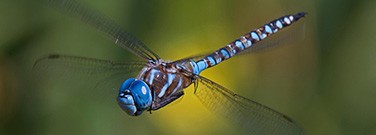Dragonflies: Masters of Flight

By Iva Fedorka
Dragonflies, with their long and brightly colored bodies, are one of the oldest insect species and some of the earliest flight innovators. A Cornell University group led by Jane Wang, professor of mechanical engineering and physics, is exploring how dragonflies can right themselves when falling upside down.
The team’s paper was published in Science on May 12, 2022, by coauthors James Melfi, Ph.D. ’15 and Anthony Leonardo of Howard Hughes Medical Institute (HHMI) in Ashburn, Virginia. Their findings reveal a series of mechanisms that begin with the dragonfly’s five eyes and end with muscle control and wing angles.
Insect Flight
Wang has used mathematical modeling during the past 20 years to better understand insect flight mechanics. While visiting scientists at the HHMI Janelia Research Campus, she became interested in Leonardo’s 3D dragonfly tracking work.
“When we looked at their flight behavior, we were simultaneously in awe and frustrated,” she told ScienceDaily. “The trajectories are complex and unpredictable. Dragonflies constantly make maneuvers without following any obvious direction. It’s mysterious.”
The Investigation
In Wang and Melfi’s experiment, the dragonflies were dropped upside down from a magnetic tether and carefully released without leg contact. This test method is similar to French physiologist Étienne-Jules Marey’s 1880s falling cat experiments, where cats were dropped from an upside-down position to study how they usually land on their feet.
Markers were placed on the insects to help capture their movements using high-speed video (4,000 frames/second). With 3D tracking software, scientists analyzed the dragonflies’ motions while also considering the variable aerodynamics of wing and air interactions, the way the dragonfly body responds to wing flapping, and gravity itself.
The group was able to create a computational model that simulated dragonfly aerobatics. Wang suspected that the insects assess their body position using their visual systems — two large compound eyes and three ocelli, or simple eyes. To test her theory, she obscured the insects’ eyes and found that they had more difficulty righting themselves in flight without vision.
The team learned that visual cues trigger reflexes that send signals to the dragonfly’s four wings, which are independently controlled. The observed rolling motion comes primarily from wing pitch asymmetry. In just three or four wing strokes, roughly 200 milliseconds, a dragonfly can rotate 180 degrees to resume a right-side-up orientation.
“It took us a very long time to understand the mechanism by which a small amount of pitch asymmetry can lead to the observed rotation. The key asymmetry is hidden among many other changes,” Wang said.
This combination of kinematic analysis, physical modeling, and 3D flight simulation offers a noninvasive way to study the connections between observed animal behaviors and their internal controls. Engineers can also use these insights to help improve performance in small flying machines and robots.
Discussion Questions
- What other animals can right themselves when flying or falling?
- How does motion tracking work?